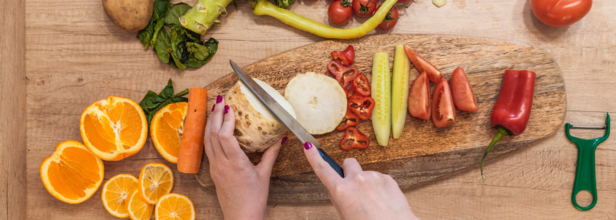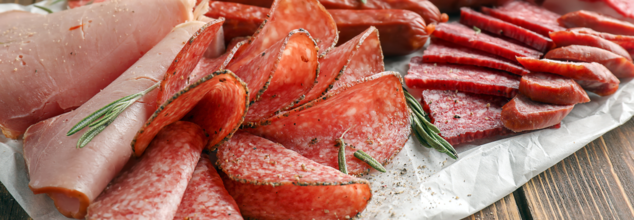- Health Conditions A-Z
- Health & Wellness
- Nutrition
- Fitness
- Health News
- Ayurveda
- Videos
- Medicine A-Z
- Parenting
- Web Stories
This Aussie Mum Lost 30kg In 3 Months, By Eating Cookies!

Image Credit: Youtube/@CookieDiet
Weight loss is a process millions want to achieve, often without getting the desired results. From rigorous exercise routines to fad diets, many people find themselves frustrated with slow or unsustainable outcomes. One such woman, Tara, a mother of four from Sydney, was no exception. She had attempted numerous diets but wasn't able to experience long-term improvements—until the Cookie Diet. Within three months, she lost an incredible 30kg, changing her life in the process.
Tara's weight gain snuck up on her. At 33, balancing a stressful job in real estate and raising four kids, she hardly had time for herself. It wasn't until she saw a professional picture of herself taken for work purposes that reality sunk in. Weighing 94kg at the time, she felt embarrassed and didn't want to employ the use of the photo for business cards. This turning point was what sparked the change.
Browsing through Facebook one night, Tara came across a news story about the Cookie Diet. She initially wrote it off as another trend, but curiosity prevailed. With nothing to lose, she decided to try it out, much to the dismay of family and friends.
The Cookie Diet had promised controlled eating with minimal meal preparation—an appealing scenario for a person always in motion. The idea was straightforward: nine carefully designed cookies spread out over the course of the day, with an evening meal consisting of a balanced, high-protein meal.
Starting any new diet requires an adjustment period, and the Cookie Diet was no exception. Tara set alarms to eat her cookies at two-hour intervals, ensuring she maintained consistency. Hydration played a key role—she increased her water intake and took multivitamins to maintain energy levels and prevent deficiencies.
The first week alone saw unexpected results—Tara lost 3kg. Inspired by this, she stuck to the plan. With every week that went by, the weight on the scale kept falling, and soon even the most skeptical friends and relatives could notice the change.
What is the Cookie Diet?
The Cookie Diet is a controlled weight loss plan that helps one lose excess weight by means of portion-controlled meal replacements. It entails eating specially designed, low-calorie cookies throughout the day with a high-protein, low-carb evening meal. The diet offers an easy and convenient method of weight loss, minimizing the requirement for meal preparation and calorie counting. By suppressing hunger with regular snacking, it seeks to achieve a sustainable calorie deficit without sacrificing essential nutrients.
How Does the Cookie Diet Work?
The Cookie Diet relies on a simple concept—lots of little meals to control hunger and manage caloric intake. Individuals consume a cookie or cookies every two hours to maintain continuous energy supply with the possibility to eat more rarely. The average calorie content per cookie is approximately 60, and the number of calories to consume daily would be 1000-1200. As an addition, there is also a high-protein, low-carb, 500-700-calorie dinner to retain the nutritional integrity. This disciplined method triggers weight loss through the creation of a calorie deficit without slowing metabolism or increasing cravings. When the target weight is reached, the individual switches to a healthy, balanced eating plan.
Tara lost a whopping 15kg after two months on the Cookie Diet. The ease and effectiveness of the program kept her on track, and the compliments she received from her coworkers and clients gave her confidence.
But she understood that sustaining her results needed more than simply continuing the diet forever. Once she had achieved her weight loss target of 30kg, she slowly switched to a healthier diet, including whole foods and lean proteins. She also found a new passion for exercise, walking on her treadmill every day to keep her fit.
Is the Cookie Diet Sustainable?
The Cookie Diet has been criticized for not being sustainable in the long run, but Tara's experience refutes this. It was a temporary stepping stone that returned her to an even healthier relationship with food. When she eventually cut out the cookies, she had already established better eating habits and portion control.
Although this solution will not appeal to everyone, its organized simplicity makes it an attractive choice for those who are not successful using conventional methods of dieting.
If you're stuck, feeling overwhelmed, or can't keep up a long-term approach to diet, a different plan such as this may be worthwhile. Weight loss isn't solely about the mechanism—it's finding a system that works within your life and which you can uphold the results on. For Tara, the Cookie Diet was only a weight loss solution—it was the beginning of a healthier, more confident way of life.
Is Sunlight Really Enough To Meet Your Vitamin D Needs?

Credits: Canva
Relying solely on sunshine to meet your Vitamin D needs may not be enough—especially all year round. A recent study published in Nutrition & Metabolism, titled Vitamin D—is the sun enough for us?, has found that while sunlight helps your body produce Vitamin D, it may fall short in helping you maintain healthy levels over time. The research suggests that many people—particularly those with darker skin tones, higher body fat, or limited sun exposure—may still need supplements to meet their daily requirements.
How Much Sun Is Enough?
To get enough Vitamin D from sunlight, experts typically suggest spending about 5 to 30 minutes outdoors, a few times a week, between 10:30 am and 4 pm. But the study found that this general advice doesn’t work for everyone. Factors like where you live, your skin colour, time of year, and even air pollution can affect how much Vitamin D your body makes from UVB rays.
For instance, people living in northern latitudes or in places with long winters may not get enough sunshine for several months. And if you spend most of your day indoors, cover your skin, or live in areas with high pollution, your Vitamin D production can be even more limited.
Can Summer Sun Last You Through Winter?
Not really. The researchers explain that even if you spend more time outdoors in the summer and your body makes extra Vitamin D, it doesn’t stay in your system indefinitely. Vitamin D is stored in your fat and muscle tissues, but those reserves tend to run low by the time winter hits. This means you may still become deficient in the colder months unless you get enough from food or supplements.
Skin Tone and Body Fat Matter
Your skin color plays a major role in how efficiently you make Vitamin D. People with darker skin have more melanin, which acts like a natural sunscreen and slows down Vitamin D production. As a result, they often need longer sun exposure to make the same amount of Vitamin D as someone with lighter skin.
Body fat is another important factor. Vitamin D is fat-soluble, meaning it gets stored in fat tissue. In people with higher body fat, more Vitamin D can get trapped in fat cells and may not be easily released into the bloodstream. This can lower your blood levels even if your body has technically made enough.
On the flip side, muscle mass can actually help release stored Vitamin D more efficiently, suggesting that regular physical activity may improve your Vitamin D levels.
What About Sunscreen?
There’s a common concern that sunscreen blocks Vitamin D production. The study addressed this too, noting that while sunscreen can reduce UVB absorption, about 15% of UV rays still reach the skin. That means you’ll still make some Vitamin D even with sunscreen on. Dermatologists continue to recommend sunscreen to protect against skin cancer, and they suggest getting your Vitamin D through diet or supplements instead of skipping sun protection.
Other Sources of Vitamin D
You don’t have to rely only on sunlight. Some great sources of Vitamin D include:
Fatty fish (like salmon, tuna, and mackerel)
- Fortified foods (milk, orange juice, plant-based milks)
- Egg yolks and mushrooms
- Supplements
- Vitamin D supplements are especially helpful during winter or if you’re at risk of deficiency.
D2 vs. D3: Which One Should You Take?
The study found that Vitamin D3 is more effective than D2. D3 stays in your body longer and raises your blood levels more consistently. D2 breaks down faster and doesn’t maintain levels as well, making D3 the preferred option for most people.
How to Know If You’re Deficient
The only way to know for sure is through a blood test that measures your serum 25-hydroxyvitamin D (25(OH)D) levels. Experts recommend aiming for levels above 30 ng/mL for good health.
If your levels are low, your doctor might suggest taking daily supplements—anywhere from 600 IU to 2,000 IU, or even more if you’re obese or severely deficient.
Experts Warn Against Common Food Safety Mistakes And The Hidden Dangers In Your Kitchen

Credits: Canva
In our day to day life, foot safety usually takes back seat, because sometimes we take shortcuts. For instance, leaving the pizza out on the counter overnight, or reusing the same sponge to wash our utensils. How often have we thought these through? Microbiologists and food safety experts as reported by The Guardian, recommended that our kitchen habits, which may appear harmless could actually invite dangerous pathogens like E coli, salmonella, listeria, and even botulinum toxin.
Dr Siyun Wang, a professor of food safety engineering at the University of British Columbia, as reported in The Guardian said, "Home cooks tend to underestimate how cross-contamination can spread bacteria across the kitchen." Harmful bacteria could also transfer from raw foods to surfaces that are touched commonly, like fridge handles, or sink faucets. These bacteria could also linger longer than we expect.
What Can One Do To Minimize This Risk?
- Wash hands thoroughly with warm water and soap for 20 seconds.
- Do not rinse raw meat. Washing chicken or other meats can create airborne droplets that spread bacteria.
- Dry hands on clean towels meant only for that purpose.
Remember To Disinfect Surfaces And Kitchen Equipment
Dr Jae-Hyuk Yu, professor of bacteriology at the University of Wisconsin-Madison, recommends a bleach solution (1 tablespoon per gallon of water), an EPA-approved disinfectant, or an alcohol-based spray for sanitizing kitchen surfaces.
He told The Guardian that cleaning refrigerator shelves monthly and ensuring the fridge temperature stays below 40°F (4°C) are key to preventing bacterial growth. Gloves and good ventilation are also essential when using disinfectants.
What Is The Right Temperature To Cook Safely?
Use a food thermometer to ensure meats reach the USDA-recommended internal temperatures:
- 145°F (63°C) for whole cuts of meat and fish (with a three-minute rest)
- 160°F (71°C) for ground meats
- 165°F (74°C) for poultry
Yu, as The Guardian reports, prefers plastic cutting boards for meat preparation since wood can trap microbes in grooves. All cutting boards, regardless of material, should be cleaned thoroughly with hot water and antibacterial soap.
Should You Change Your Kitchen Sponge?
“Sponges are notorious bacterial reservoirs,” warned Yu. Using a sponge to clean raw meat residue and then using it elsewhere can easily spread pathogens.
Daily disinfection is a must:
- Microwave a wet sponge for 1–2 minutes or run it through a dishwasher with a heat-dry cycle.
- Replace sponges every 1–2 weeks.
- Better yet, opt for washable dishcloths changed daily.
How To Store Your Food?
Leaving food at room temperature overnight is “essentially incubating the bacteria that are in that food,” said an Idaho-based microbiologist who goes by Morticia on social media to avoid harassment, speaking to The Guardian.
Especially risky? Starchy leftovers like rice and pasta, where Bacillus cereus can flourish. She cautions:
- Refrigerate food within two hours.
- Limit room-temperature exposure to four hours at most (less outdoors).
- Discard refrigerated leftovers after three to four days.
Other Small Tips And Tricks To Safely Cook And Prepare Meals
Expiration Dates: Dr Alvaro San Millan from the National Center for Biotechnology in Madrid told The Guardian that "use by" dates must be followed strictly. He suggested that even when something smells fine, there could be harmful bacteria like salmonella that could be presence in levels too low to detect. In case the food smells or tastes funny, it must be avoided.
Moldy Cheese: When it is a moldy cheese, experts suggest that you could cut off the mold if it forms on hard cheese, like cheddar. However, make sure that it is at least an inch around the mold that could make a cut so to throw away any spread of the bacteria. However, if you see mold with soft cheese, it is best to throw it away. “The knife should be kept away from the moldy part to avoid cross-contamination,” Wang told The Guardian.
Spices And Labels: Adding salt, spice, or acid isn’t a failsafe method to keep food safe. Morticia points out that even pickled foods have been involved in listeria and salmonella outbreaks. Likewise, organic produce is not inherently less risky in terms of bacterial contamination.
There Is No 'Safe' Amount Of Processed Meat To Eat, New Study Finds; How You Can Avoid While Dining Out?

Credits: Canva
For decades, nutrition experts have urged moderation when it comes to processed meats. Think bacon, hot dogs, sausages, ham, and deli meats. They’ve long been linked to increased risks of heart disease, cancer, and type 2 diabetes. But a major new study suggests that moderation may not be enough. According to researchers, there is no "safe" amount of processed meat consumption—even the smallest daily serving could heighten health risks.
This research, conducted by a team from the University of Washington in Seattle, analyzed over 70 previous studies involving several million participants. Their findings challenge the notion that small or occasional consumption of processed meats is harmless, suggesting instead that even minimal intake can incrementally raise the risk of serious health conditions.
Even minimal habitual intake of processed meat could elevate the risk of type 2 diabetes and colorectal cancer—and no amount was proven to be risk-free.
Processed meats are defined as meats that have been smoked, cured, salted, or preserved with chemical additives. These methods, while extending shelf life and enhancing flavor, introduce compounds such as nitrates and nitrites that have been tied to adverse health outcomes.
In the new study, researchers employed what’s known as the Burden of Proof methodology—a conservative statistical model that avoids exaggerating risk. The study’s strength lies in its cautious approach, meaning its results are likely understatements of the actual risks.
One of the more shocking findings was that consuming just one hot dog per day was associated with:
- An 11% greater risk of developing type 2 diabetes
- A 7% greater risk of colorectal cancer, compared to no processed meat consumption at all.
Dr. Christopher Murray, one of the senior researchers involved, emphasized that “monotonic increases in health risk”—a pattern where more consumption consistently led to more harm—were observed across multiple disease categories. This pattern strongly suggests no threshold of safety.
What About Sugary Drinks and Trans Fats?
While processed meat fared the worst in the analysis, other dietary culprits didn’t escape scrutiny.
Consuming just one can of sugar-sweetened soda daily was linked to:
- An 8% higher risk of type 2 diabetes
- A 2% increased risk of ischemic heart disease
Even a small daily intake of trans fatty acids, commonly found in processed baked goods and margarine, increased the risk of heart disease by 3% compared to no intake.
These results, while seemingly modest, are significant at the population level—especially when you consider that these dietary habits are widespread. It’s crucial to interpret these findings with nuance. The study’s associations, while consistent, are relatively weak and do not establish direct causation. Much of the data is based on self-reported dietary habits, which can be prone to inaccuracies. However, the conservative methodology means the reported risks are likely minimum values, potentially underestimating the true dangers.
A commentary published alongside the study acknowledges the role of ultra-processed foods in improving food accessibility and shelf life, especially in regions with limited access to fresh produce. But the overarching message is clear: cutting down on processed foods is the safest bet for long-term health.
Why Processed Meat Is So Risky?
Processed meats are typically preserved by smoking, curing, salting, or adding chemical preservatives. These processes introduce or enhance compounds—such as nitrates, nitrites, and certain hydrocarbons—that have been shown to damage DNA or promote inflammation, both of which are linked to cancer and metabolic diseases.
The World Health Organization has previously classified processed meat as a Group 1 carcinogen, putting it in the same category as tobacco and asbestos in terms of cancer risk. This new study reinforces and expands on those concerns, highlighting the risks not just for cancer, but also for diabetes and heart disease.
Cutting Down on Processed Meat, Especially When Dining Out
Aim to fill at least half your plate with colorful vegetables. Think leafy greens, bell peppers, squash, and tomatoes. These nutrient-rich foods not only displace processed items on your plate but also provide protective health benefits. Completely eliminating it might not always be feasible—but experts offer strategies for cutting back in meaningful ways, especially when eating outside the home.
1 . Fill Half Your Plate With Vegetables
When dining out, aim to make vegetables the star of your meal. Choose a variety of colorful options—spinach, peppers, pumpkin, and more—to maximize nutrients and minimize the space for processed meats.
2. Avoid the Deep Fryer
Fried foods, often paired with processed meats, add unnecessary fats and calories. Opt for dishes that are grilled, baked, steamed, or sautéed instead of battered and deep-fried.
3. Pick Wholegrains
Look for menu items featuring wholegrain ingredients like brown rice, wholemeal pasta, barley, or quinoa. These not only provide more fiber and protein but also help you feel full, reducing the temptation to reach for processed meats.
4. Choose Less Processed Meats—If You Must
If you’re unable or unwilling to go fully vegetarian, select less processed cuts of meat such as grilled chicken breast or fresh fish. Avoid sausages, bacon, and deli meats whenever possible.
5. Share Plant-Based Dishes
When eating with others, suggest sharing plant-based appetizers or side dishes. This not only diversifies the meal but also reduces the overall consumption of processed meats.
The challenge, especially in low-resource settings, is to balance the benefits of food accessibility and shelf life with the imperative to reduce health risks. Innovations in food technology and policy interventions will be essential to achieve this balance.
As researchers continue to unravel the health consequences of ultra-processed foods, one message is resoundingly clear: the safest route is to limit processed meats as much as possible—and fill your plate with whole, minimally processed ingredients that support long-term health.
© 2024 Bennett, Coleman & Company Limited

